

...or to Infrared Photography
|
E-500IR An infrared-only conversion of the Olympus E-500 |

|

|
Back to the Olympus E-System...
...or to Infrared Photography |
|
If you are new to the subject of infrared photography and/or IR camera conversion, here are two articles you may consider as pre-requisites to this one: Otherwise keep on reading. |
|
At long last I decided to bite the bullet and have one of my digital SLRs adapted for infrared. Instead of retiring my Olympus E-500, I'm giving it a second career. Why the E-500? First of all, it is an excellent camera by itself. I like everything about it, from ergonomics to image quality. While it excels in the color and tonality department, the images are not as razor-sharp as those from the E-510 (and other newer Olympus models using NMOS sensors), most probably due to a stronger anti-aliasing filter. This filter doubles up as an anti-IR one, stopping the infrared from reaching the sensor. Removing it will not only make the camera IR-capable, but may also improve detail rendering — or at least so I hope. We will see. Decisions... Lacking the mechanical skills, necessary parts, and equipment (including the clean environment), I had to find someone to do the conversion for me. Two companies doing that have been around for a while: LDP (MaxMax) and Life Pixel; both seem to be reputable enough. In short: I chose LDP, because their Web site answered most of the questions I had — except for the critical one: would they convert my E-500? It is not listed among models supported, but the LDP ad in Popular Photography mentions Olympus SLRs. I've sent Mr. Llevellyn, the company president, an email asking about this; it turned out I'm OK: yes, they do the E-500 (and, by the way, the E-510); I'm still not sure about other models, except for the E-330, which is not supported. As a matter of fact, I can't help but quote Mr. Llevellyn on the latter camera: "We once modified the E-330, but it is a very difficult camera to convert and [we] won't be doing [it] any more. [...[ The E-330 was like taking apart a watch. I was surprised that I actually put the thing back together and had it work [...]" I'm not surprised: the E-330 feels like a Rube Goldberg contraption. A quote from MaxMax.com, the LDP Web site: "We have a class 100 optical clean bench, plasma chamber, ionized air curtain, static control mats, pressurized ionized nitrogen air guns, lab grade solvents and materials, alignment and calibration equipment and the experience to convert cameras properly." This also sounds serious (I had to do some reading to check what Class 100 is, and it turned out a good thing to have). I was also unsure how to understand the claim of autofocus being adjusted in IR-only conversions. This was what I've got in response to my original email question: "Tuning AF on an IR-Only E-510 is a matter of using the glass with the correct refractive index to compensate for the typical IR focal shift." This simple correction is what I expected; it should be good enough for most typical lenses, and any claims beyond that would be unrealistic. To make things clear, at the moment of that exchange my respondent was not aware that I am running a photography site, or planning to write an article about this conversion. Some experienced IR photographers whose opinions I trust (like Lloyd L. Chambers) also had only good things to say about LDP, and that counts. Additionally, I was a bit put off by the fact that Life Pixel runs an "affiliate program", offering a 15% kickback to Web publishers who send them customers. The writer may, or may not, disclose this affiliation; while this may be a common practice, it makes me wary. When deciding between IR+visible or IR-only conversion was quite simple (do just one thing but do it right), there was another choice I had to make here: what kind of IR filter to put into my camera. LDP offers two kinds of glass: one with a 715 nm cut-off and one with a cut-off at 830 nm. They are using the premium Schott glass, so I assume that these values are derived from Schott's RG715 and RG830 notation. According to my IR filter list, the first one corresponds to Wratten #88A, a bit more restrictive than the popular R72 (Wratten #89B), with 50% transmittance at about 750 nm. The second kind moves more out of the visible range, reaching 50% at about 850 nm (Wratten #87C). This is 55 nm higher than the second most-popular IR filter, the Tiffen 87 (Wratten #87). The decision is not so simple, as both filters have their pros and cons.
A tough choice. An image based mostly on the red layer (the first option), while nominally in 8 MP resolution, is really interpolated from 2 MP worth of photosites. Still, I'm gaining two EV worth of exposure, nothing to sniff at! In the very last moment, after lots pf procrastination, I decided in favor of 715 nm glass, for better or worse. What prevailed, in addition to shorter exposure times, is that I'm more used to tonality of images produced with use of the R72 filter. Camera modification The next step was to have the camera bubble-wrapped, packed, and sent to LDP with a check and a short cover letter. This was done one Monday; next Wednesday my E-500 was back, with the UPS tracking number provided by LDP via email. This (including time in transit and the time it took my check to clear) is close enough to the "official" two-day turnaround time, nothing to complain about. The camera arrived as expected: clean and functional. Switching it to the cleaning mode (mirror up, shutter open) revealed the new, darker filter behind the shutter; no visible dust in the mirror chamber. The first image samples shot through the window of my office turned out as expected, no surprises. Time for fun and games: a detailed analysis of how it works after the surgery. First tests Within minutes from unpacking my E-500IR I was at work checking its performance. And here I have good news and bad news to report.
I have no doubt about the last item in this list. The E-500 has a nifty focus bracketing feature, allowing you to shoot a series of frames: one "as focused" (using the on-demand AF, if you choose so) and another four or six at a number of focus offset values. In all cases the sharpest result was four or six "steps" (set by Olympus to some arbitrary value) ahead of the measured distance. The results at the nominal AF were very bad. While I will be investigating this in the coming days, I had to find a work-around for the problem. Manual focusing with use of the finder is out of question: it suffers from the same problem, as the process uses visible light. I found out that (at wider lens angles) I can use the "on demand" AF on my toes in order to shoot at infinity, stepped down to F/8, but this needs more work. It looks like, for the time being at least, I ended up with a high-performance infrared camera limited to manual focus. Oh, well — who said infrared photography has to be easy? First samples Here are a few samples from the first session with my E-500IR. It is early April, and the leaves are only beginning to show up, so that the bright-foliage Woods effect is not as prominent as it will be in a week or two, but this should be enough to give you some idea. Original out-of-camera JPEGs are shown at the left (just reduced and re-sharpened), images after some postprocessing — at the right. The images link to larger versions (full-size originals or postprocessed XGA, respectively). All pictures in this series were shot using the 14-45 mm F/3.5-4.5 ZD lens at 14 mm; manual focus mode with AF "on demand" set on my toes. Aperture priority (-0.3 EV) at F/9.0, exposures of 1/125 or 1/200 s, ISO 100; saved as in-camera JPEGs. The white balance was at 3000 K (tungsten) with maximum allowed compensations towards cyan and green; Natural Picture Mode with contrast and sharpness at -2. Postprocessing (Photo-Paint) included stretching of all three color component histograms individually to fill most of the available range, reducing color saturation by 75% or so, some contrast enhancement, and then sharpening (unsharp mask; more of it than I would like to use). The second sample also underwent some perspective correction. |
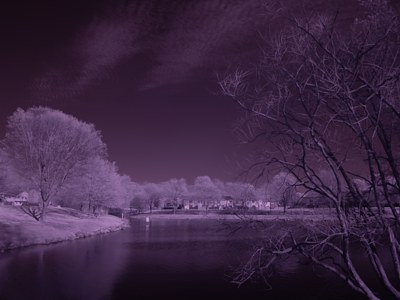
|
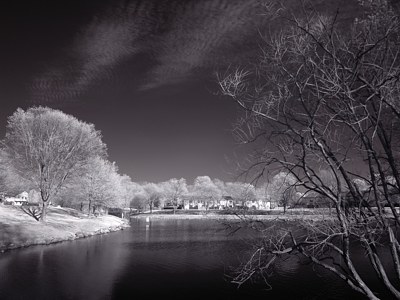
| |
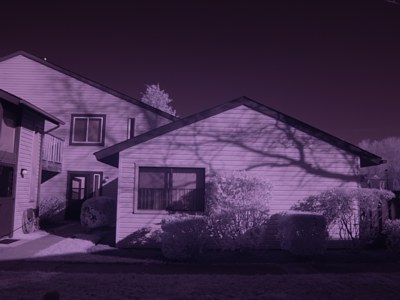
|
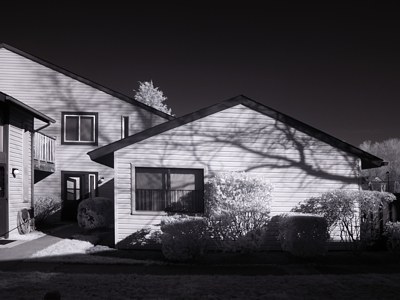
| |
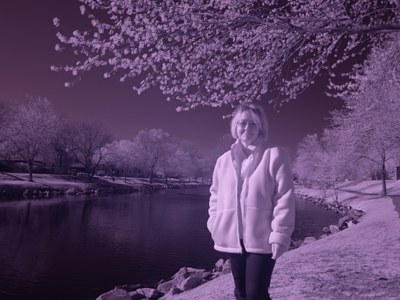
|
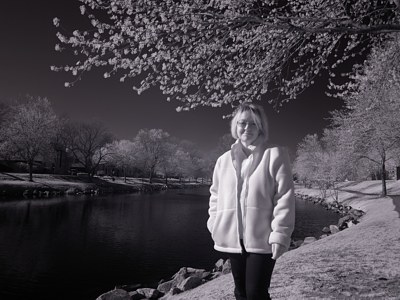
|
|
Overall, a satisfying experience and quite good results. No need for these long, non-handholdable exposures, plenty of light to provide satisfactory tonality and low noise. The only fly in the ointment is the autofocus problem. On that subject — more to come when I find time for more experimenting. |

|

|
Back to the Olympus E-System...
...or to Infrared Photography |
| Home: wrotniak.net | Search this site | Change font size |
| Posted 2008/03/17; last updated 2009/01/21 | Copyright © 2008-2009 by J. Andrzej Wrotniak |